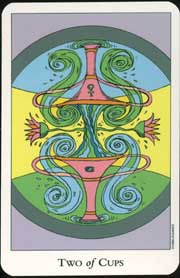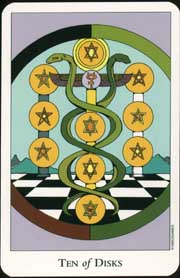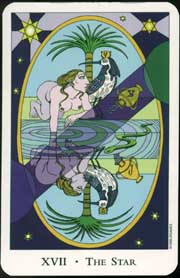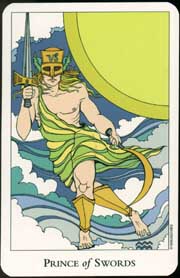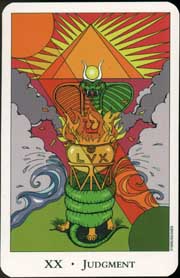Tarot of the Sephiroth Deck Review
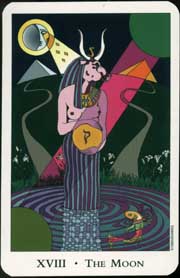
Creators: Dan Staroff
Publisher: US Games 2001
The major arcana of the Tarot of the Sephiroth are fascinating. The art is angular and abstract, incorporating qabbalistic spheres, and the cards can be laid out showing the paths in the Tree of Life. However, the minor arcana do not match the majors in detail and interest.
Retailers
See Price at Amazon.comSee Price at Amazon.com (Set)
See Price at Amazon.co.uk
See Price at Amazon.ca
Tarot of the Sephiroth Review by Moongold
The main aim of this deck is to introduce people to the connections between the Tarot and Qabalah. I have been delighted with the manner this deck achieves this for the beginner. This is not to say that Tarot of the Sephiroth is a deck for beginners alone. The deck stands in its own right as a refreshingly different deck in terms of art and ideology and many experienced Tarot readers will find it a worthwhile addition to their collections. The structure of the deck itself is traditional, with 22 major arcana, 16 courts and 40 pips. The deck uses striking imagery and colour and the art work is unique and contemporary. In fact, it reminds me very much of sophisticated comic book art, incisive and witty in its own right.
The images were originally drawn in pen and ink, scanned into a computer, with colour being added later, They were intentionally given a two dimensional effect, aimed at replicating the style of Egyptian hieroglyphic art in a contemporary milieu. The major arcana are outstanding, with very strong and powerful representations of archetypal figures. The images include the use of vibrant colour to set the mood and varied symbolism to convey meaning. Some of the traditional Tarot characters are given dynamic new visual interpretations. The Hermit, the Empress and the Hanged Man are three memorable images in this deck. No reticent character with a lantern, the Tarot of the Sephiroth Hermit is Moses, perfectly depicting the power of internal reflection and change. His staff strikes water from stone and tablets of knowledge rest at his feet. And he Empress is just glorious! She stands, gracefully powerful against subtle shades of green and purple, surrounded by symbols of her role, crescent moons, doves, lotus flowers and the crown of Demeter. The Hanged Man reflects the position of the foetus in the womb, thus making connections with creative feminine energy.
Symbolism in this deck includes astrological, elemental and Qabalistic attributions and many mythical associations from Greek, Roman, Hebrew and Egyptian settings. In fact, all the major arcana images are crowded with meaning and colour but once one feels at home with the symbolism, this deck is a very easy one to read. There is an unusual feeling of power in all the images, particularly those representing the feminine. I also enjoyed the quirky wit and humour subtly present throughout the deck.
The minor arcana are unusual. They are essentially non-scenic but make very strong use of primary associations and colour. For people who are interested in learning to read using elemental and numerological associations but donít want to yet explore Marseilles decks, the Tarot of the Sephiroth is an excellent alternative. I actually found the minor arcana images very easy guides to meditation. The simplicity and freshness of the images enhanced this aspect for me, with robust depictions of the suit elements against flawless and pure pastel backgrounds.
The connections between the Tarot and Qabalah are extensively explored in the companion volume to the Tarot of the Sephiroth. There are diagrams of the Tree of Life, definitions and explanations in the general text. Each card has a detailed explanation of the symbolism and some suggested meanings. In fact, this deck companion is one of the best of its kind I have seen. There are many unexpected and useful sections to it Ė principles of divination, explanations of the court cards, numerology and elements and some unusual spreads written especially for this deck. The authors of the guide, Josephine Mori and Jill Stockwell deserve much credit.
For me, the Tarot of the Sephiroth did achieve its promised aims in terms of making the Qabalah more accessible but it also achieved what all good education does - the awakening of a compelling interest in further exploration of the Qabalah and Tarot, and their connections.
Tarot of the Sephiroth Review by Bonnie Cehovet
In a card accompanying this deck, creator Dan Staroff notes that this deck was created from a desire to present a more unified and comprehensive portrayal of the Tarot. His wish was two fold: to interpret the traditional Tarot images for a new era, and to highlight the connection between Tarot and the Qabalah. In doing so, use was made of the Tree of Life, its spheres and paths, and associated colors.
The LWB (Little White Book) that accompanies the deck notes that the images on the Tarot cards act as links to connect elements of the human condition and the universal (archetypal) forces that affect all of us. The "Tarot of the Sephiroth" brings the Tarot/Qabalah connection to life through the laying out of the cards as they are associated with the spheres and paths of the Tree of Life. The LWB contains graphics that show the spheres, their numbers, and their associated colors.
The Major Arcana are represented according to their color correspondences. The Minor Arcana represent the energies of the ten spheres, and are shown with circular borders in their respective corresponding colors. The biggest change that this represents for the reader is that when multiples of the same number appear in a reading, it is very easy to see that they are associated, and the energy that they carry. In an overlay of the two's, three's, sixes and tens, the borders of these cards will align with the appropriate sphere formed by the joining of the Court Cards in their respective spheres.
The format of this deck is traditional - the Major Arcana follow traditional numbering (with Strength as VIII and Justice as XI) and titles. The suits are Wands, Cups, Swords and Disks (Pentacles). The Court Cards are Princess, Prince, Queen and King. The Pips (numbered cards) are very much in the Marseilles style, in that they are not illustrated.
The colors are very vibrant and intense. The art style is two-dimensional, and very "futuristic" in look. In some of the cards (the Hierophant, the Chariot, Strength, the Wheel of Fortune, the Tower, Judgment, and the Universe) there is a trace of Egyptian influence. Heavy use is made of color associations, esoteric symbolism and geometric form.
The cards themselves are 3" by 4 1/2", on good quality, glossy card stock. They are a bit difficult to handle for smaller hands. The back of the cards shows a 1/4" white border, surrounding a black background superimposed with many white stars. (A rendition of the night sky.)
The face of the Major Arcana shows a 1/4" white border, with the number and title in black across the bottom of the card. Each card carries part of a circle, with its corresponding Qabalistic color. Put together, the cards form a living Tarot Tree of Life. Several card stuck out as being quite interesting. The Fool shows a figure surrounded by a swirl of energy, appearing to come down to the earth from the sky. Above him is a blue "primordial egg", with golden rays emanating from it, and an esoteric symbol superimposed over it. The High Priestess stand between two pillars, and appears to hold a scroll in each hand. The text on the right hand scroll reads "ATOR/TARO:, and the text on the left hand scroll reads "ORAT/ROTA". The Hierophant is seated, with his left foot over a snake. He holds a scroll in his lap, with glyphs of the Sun and Moon appearing over his right and left shoulders respectively. The Hermit is shown seated, his right arm raised, with his palm out, and a scepter held in his left hand. The Hanged Man is shown with his right foot out of the water, and the rest of him hanging upside-down under water. All of the cards are quite intricately done.
The face of the Pips shows a 1/4" white border, with the card number and suit written out in text on the bottom of the card. The pips are not illustrated, with the exception of color. Each glyph is featured within a symbolically colored circle in the middle of the card, and the astrological symbol and planetary sign somewhere on the card. There are some interesting anomalies, such as the Seven of Swords showing seven different styles of swords; the Six of Swords showing two triangles - a Gold triangle in the upright position, and a Silver triangle superimposed over it in the reversed position; each of the Ten of forming the Tree of Life; the Two of Wands showing two different types of wands; and the Six of Cups showing six cups in a circle, with an upright Gold triangle in the middle, and a reversed blue triangle superimposed over it.
The Court Cards show figures that strongly resemble Egyptian figures, and carry a circle with the associated symbolic color on them.
The LWB presents the cards with text only - no scans. The card name and number, a brief description of the picture, the energies of the path, and the evolutionary state are included. From the book:
IX The Hermit
Pictured: Moses, one of the great magicians of the western mysteries. Energies of the Path: Productive solitude, new awareness, the wayshower Evolutionary State: inspired wisdom and experience.
Ace of Wands
Pictured: A flaming Wand above a green field. Meaning: Source of spirit, volatility, vitality.
Princess of Swords
Pictured: An Amazonian Princess stands on a circle of airborn Swords. Meaning: Activism, commitment, intellectual persuasion.
Two spreads are included at the end of the book: "Will He/She/They Call?", and "Energy/Form/Direction". The first spread I will not spend my time on. The second spread is worth noting: the first card represents the energy of the matter, the second card represents the form this energy will take, and the third card represents the resulting direction of the matter.
Visually, and from an esoteric point of view, this is an appealing deck. However, unless you purchase the accompanying book, you might not have a clue how to put the cards into the form of the Tree of Life. I was lucky, in that I have worked with the Qabalistic material from the Tarot School, and knew where the cards should be placed. This is not a deck for beginners, but it has a place in an esoteric deck library, and works well for meditation, ceremony, and ritual work.
© Bonnie Cehovet
Complete Details of Tarot of the Sephiroth
Creators: Dan StaroffPublisher: US Games 2001
Deck Type: Tarot Deck
Cards: 78
Major Arcana: 22
Minor Arcana: 56
Deck Tradition: Golden Dawn
Minor Arcana Style: Decorated Pips
Suits: Cups, Swords, Wands, Disks
Court Cards: Princess, Prince, Queen, King
The Fool is 0
Strength is 8
Justice is 11
Card Size: 2.95 x 4.53 in. = 7.50cm x 11.50cm
Card Language: English
Card Back: Unknown
Rating: 14/20 or
Similar Decks to Tarot of the Sephiroth
Theme: Occult, Qabalah< Previous Deck · Back to Top · Next Deck >
Home > Tarot Reviews > Tarot of the Sephiroth Review

